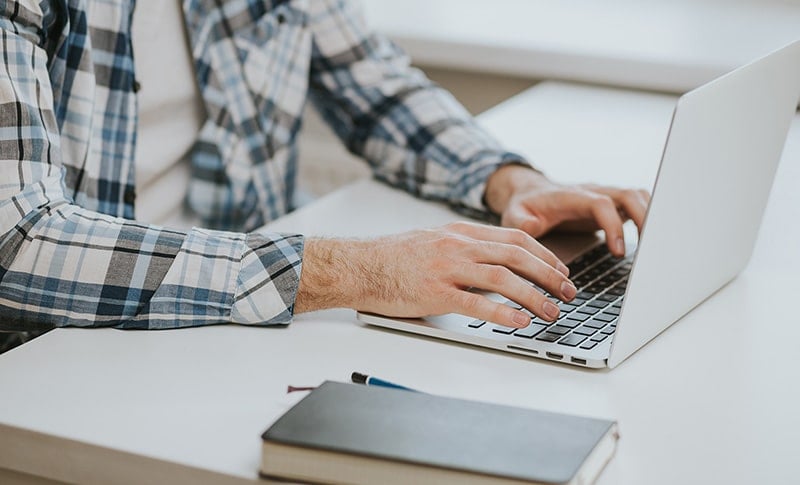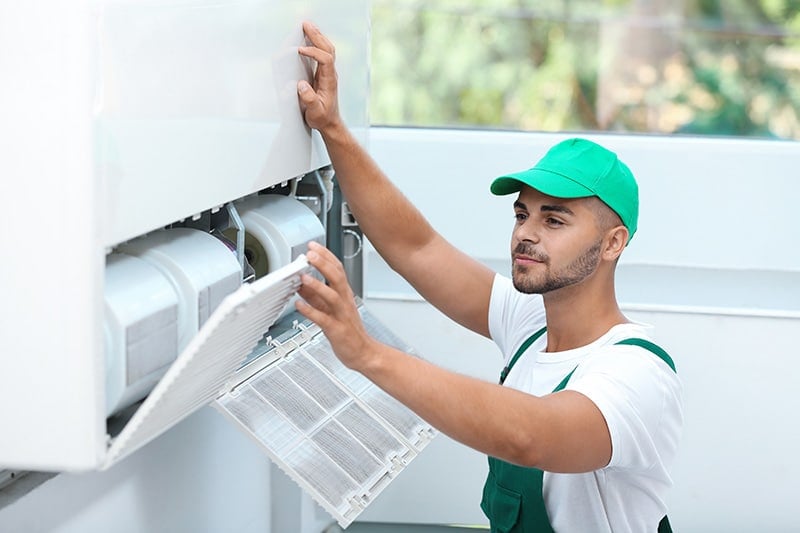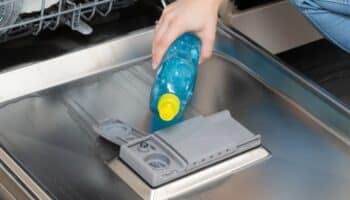We've independently reviewed this article to make sure it's as accurate as we can make it.
To find out more about our article creation and review process, check out our editorial guidelines.
Does your dishwasher keep leaking?
You’re not alone! I know how annoying it can be to constantly mop the water on your kitchen floor.
Luckily, you’ve come to the right place.
If your dishwasher is leaking water, chances are it’s leaning forward, or there’s an issue with the door seal, spray arm, actuator, or float switch.
Ready to fix your dishwasher leak? Read on!
Why trust us? This article was written by Craig Anderson and James Blackford.
Craig has helped thousands of other homeowners repair their appliances since 2016. James is one of our resident appliance experts, with over 16 years of experience. He currently works as a Master Technician for SquareTrade, and runs his own appliance repair business.
7 Reasons Why Your Dishwasher Is Leaking
In my experience as an appliance repair expert, I’ve noticed that dishwasher leaks are the most common issues people encounter.
Unfortunately, your dishwasher can leak water due to numerous reasons. Some of the most common ones include:
#1 Damaged Door Gasket
If your dishwasher is leaking water and flooding your kitchen, I first recommend checking the door gasket.
The gasket creates a seal between your dishwasher and its door, ensuring the water stays inside and not all over the floor.
If the door gasket has never been cleaned or is worn out, it will not effectively seal the door, resulting in water leakage. A brand-new seal costs around $10 to $20, so I recommend replacing it before attempting other solutions.
Bear in mind that you’ll need to look at the manual to figure out what model is right for your dishwasher to ensure you end up with the best possible seal.
Here’s how to replace the door seal:
To prevent electrical hazards, it’s crucial to disconnect your dishwasher before replacing any of the components mentioned in this article.
- Clean the channel of the gasket with warm water. You can use soap to remove any debris that might be present.
- Ensure the new door gasket is warm when you put it in place. The goal is to make sure the door gasket molds to meet the shape of your dishwasher door.
- Press the gasket evenly on both sides. When you close your dishwasher door, make sure it seals appropriately to prevent the water leak from coming back.
#2 Your Dishwasher is Leaning Forward
If your dishwasher keeps leaking water, then there’s a good chance it’s leaning forward. This can disrupt the proper flow of water, as it can accumulate towards the front.
So, please ensure your dishwasher is not leaning forward to prevent leaks.
When you compare the size of your dishwasher to the surrounding cabinet, you can determine the direction in which it’s leaning. Ideally, you want your dishwasher to have a slight backward lean rather than leaning forward.
#3 A Faulty Spray Arm
Dishwasher leaks can also be caused by a damaged, broken, or clogged spray arm.
You see, the spray arm is responsible for distributing water and getting your dishes clean. So, if it’s cracked or damaged, it can result in water being forcefully expelled straight out instead of being directed upwards through the spray holes. Consequently, the water will hit the dishwasher door and lead to leakage.
To check your spay arm, I recommend removing the dish rack and spinning the arm to ensure it’s moving properly.
If it’s not, please look at the utensils and ensure they are not in the way. If something is blocking the spray arm, you need to remove it.
I also recommend looking at the arm and ensuring it is not clogged due to residue buildup. If it is, please clean it.
In my experience, soaking the spray arm overnight in vinegar can help break down any stubborn food residue.
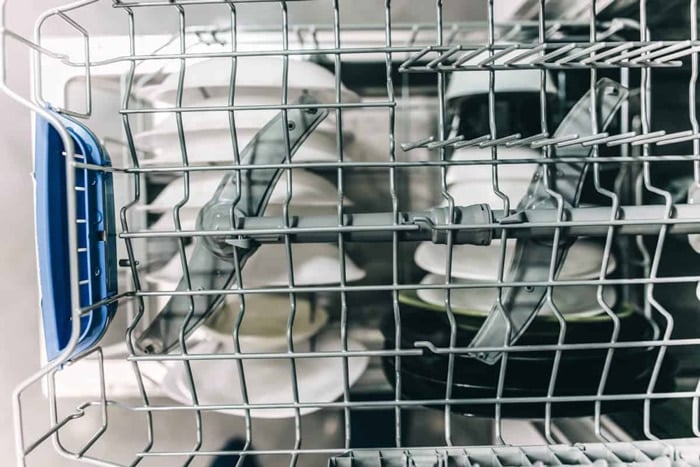
If you’ve cleaned the spray arm, but it’s still not working properly, you need to order a new model. Look at the manual and see what type of spray arm you require.
When the new option arrives, unscrew the spray arm and remove it from your dishwasher. Then, take the new arm and align it with the central hub. Screw the arm in place, and make sure it can spin freely.
Keep in mind that the process of replacing a spray arm will vary depending on the specific model you own.
#4 There’s an Issue With the Actuator
If you notice a water leak coming from the bottom of your dishwasher, there’s a good chance there’s an issue with the actuator.
An actuator controls the direction of water flow between the lower and upper spray arms.
It is a motor that is powered and operates a stem that extends up through the sump, which is the area that holds the water. The stem is connected to an assembly that moves and performs certain functions related to water flow.
Along the path to the sum, there’s a small seal. If worn out or damaged, it can result in a water leak.
I recommend contacting a professional to inspect the actuator, as accessing this component can be a bit challenging.
#5 The Drain Hose Is Damaged
If you’ve tried the fixes above but are still struggling with dishwasher leaks, you’ll need to check the drain hose.
The drain hose supplies water to your dishwasher from the drain pump. Eventually, the connections can become loose or the hose itself could crack, leading to leaks.
So, if you see water all over the floor, please take a look at the drain hose from top to bottom.
In my experience, the easiest way to detect a water leak is by running water through it to see it. If there is a leak, you can solve the issue in two ways.
When the wash cycle is over, remove power from your appliance. Then, place a pan underneath the dishwasher and pinch the hose clamp tightly, ensuring the fittings are tight. Please run another cycle and see if there is still a leak present.
If there is still a leak present, you need to replace the leaking drain hose. Look at the manual and see what type of hose is recommended.
Then, when the new hose arrives, swap out the old one for the new one. If you are uncomfortable with replacing the hose, I recommend contacting a professional who can help you.
#6 The Inlet Water Valve Is Not Functioning Properly
In my experience, a dishwasher can also have leaking issues if the water valve is not working correctly.
The inlet water valve is at the bottom of your dishwasher and allows water to flow into the tub during the washing cycle.
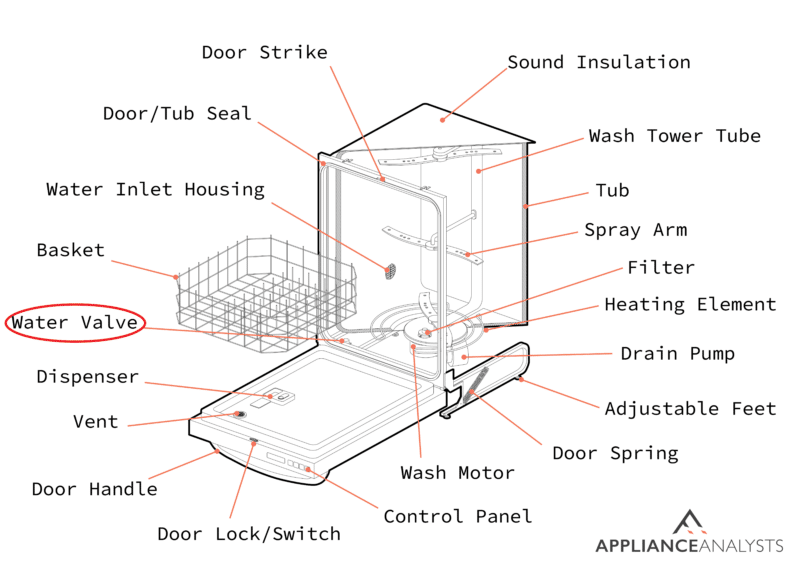
Your dishwasher can overflow if the water valve is not opening and closing properly. As a result, the excess water will end up all over the floor.
I recommend starting a wash cycle and opening the door in the middle of the cycle. If water continues to fill in your dishwasher even when the door is open, then there’s likely an issue with the inlet water valve.
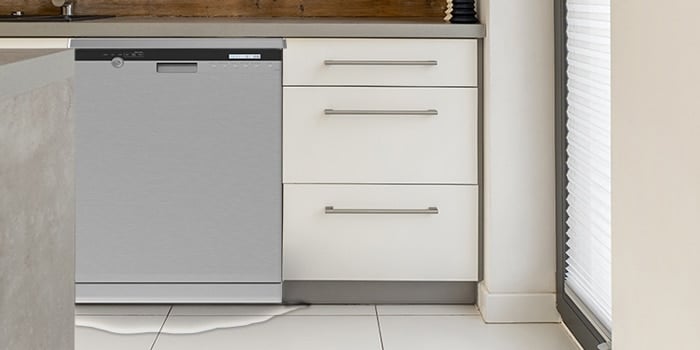
In my experience, the most effective way of dealing with a faulty water valve is by replacing it with a new one.
#7 The Float Switch Is Not Working Properly
If your dishwasher keeps leaking water, then it’s time for us to check the float switch.
You see, when your dishwasher runs, the float lifts as the water level rises.
When your dishwasher reaches a certain water level, the float switch is responsible for turning off the water. If something is wrong with the switch, the water won’t shut off. As a result, your dishwasher will leak water.
I recommend opening the door in the middle of the cycle to determine if the float switch is the culprit. Take a look at the heating element and compare it to the water level. If the water level is above the heating element, then there’s something wrong with the float switch.
If you cannot get the door open in the middle of a wash cycle, you can also test the float switch using a multimeter. If you’re not getting the manufacturer’s recommended readings, it is time to replace the float switch.
Please look at the manual to determine what you need. Then, I recommend calling a professional.
If you start messing with the internal components of the electrical wiring of your dishwasher, you risk voiding your warranty and getting harmed. So, if you are uncomfortable with this, please get in touch with a professional who can help you.
Conclusion
Hopefully, now you’ll be able to fix your dishwasher leaking issues.
Remember, you need to make sure your appliance is not leaning forward, check your spray arm, or replace the door gasket to prevent dishwasher leaks.
It’s also important to inspect the actuator, drain hose, float witch, and water valve.
Thank you so much for reading this article! I hope you enjoyed it and learned more about why your dishwasher might be leaking. Take a look at other free related articles below!

